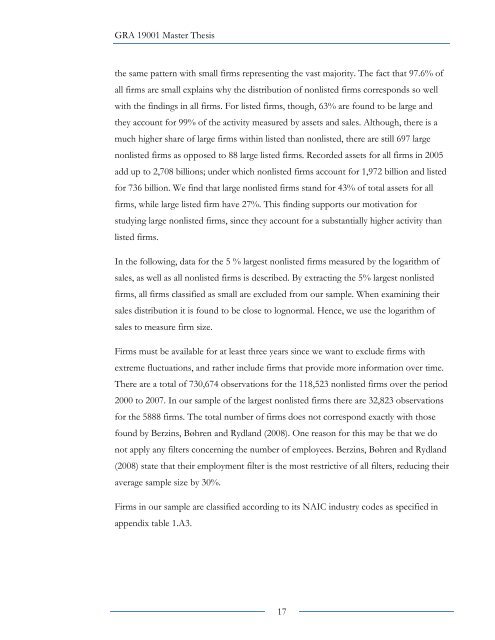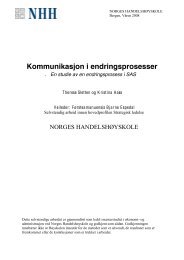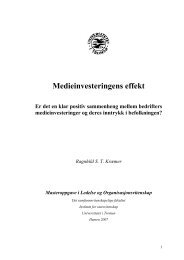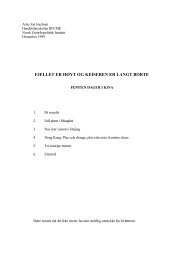Gender Diversity on the Board - BI Norwegian Business School
Gender Diversity on the Board - BI Norwegian Business School
Gender Diversity on the Board - BI Norwegian Business School
You also want an ePaper? Increase the reach of your titles
YUMPU automatically turns print PDFs into web optimized ePapers that Google loves.
GRA 19001 Master Thesis<br />
<strong>the</strong> same pattern with small firms representing <strong>the</strong> vast majority. The fact that 97.6% of<br />
all firms are small explains why <strong>the</strong> distributi<strong>on</strong> of n<strong>on</strong>listed firms corresp<strong>on</strong>ds so well<br />
with <strong>the</strong> findings in all firms. For listed firms, though, 63% are found to be large and<br />
<strong>the</strong>y account for 99% of <strong>the</strong> activity measured by assets and sales. Although, <strong>the</strong>re is a<br />
much higher share of large firms within listed than n<strong>on</strong>listed, <strong>the</strong>re are still 697 large<br />
n<strong>on</strong>listed firms as opposed to 88 large listed firms. Recorded assets for all firms in 2005<br />
add up to 2,708 billi<strong>on</strong>s; under which n<strong>on</strong>listed firms account for 1,972 billi<strong>on</strong> and listed<br />
for 736 billi<strong>on</strong>. We find that large n<strong>on</strong>listed firms stand for 43% of total assets for all<br />
firms, while large listed firm have 27%. This finding supports our motivati<strong>on</strong> for<br />
studying large n<strong>on</strong>listed firms, since <strong>the</strong>y account for a substantially higher activity than<br />
listed firms.<br />
In <strong>the</strong> following, data for <strong>the</strong> 5 % largest n<strong>on</strong>listed firms measured by <strong>the</strong> logarithm of<br />
sales, as well as all n<strong>on</strong>listed firms is described. By extracting <strong>the</strong> 5% largest n<strong>on</strong>listed<br />
firms, all firms classified as small are excluded from our sample. When examining <strong>the</strong>ir<br />
sales distributi<strong>on</strong> it is found to be close to lognormal. Hence, we use <strong>the</strong> logarithm of<br />
sales to measure firm size.<br />
Firms must be available for at least three years since we want to exclude firms with<br />
extreme fluctuati<strong>on</strong>s, and ra<strong>the</strong>r include firms that provide more informati<strong>on</strong> over time.<br />
There are a total of 730,674 observati<strong>on</strong>s for <strong>the</strong> 118,523 n<strong>on</strong>listed firms over <strong>the</strong> period<br />
2000 to 2007. In our sample of <strong>the</strong> largest n<strong>on</strong>listed firms <strong>the</strong>re are 32,823 observati<strong>on</strong>s<br />
for <strong>the</strong> 5888 firms. The total number of firms does not corresp<strong>on</strong>d exactly with those<br />
found by Berzins, Bøhren and Rydland (2008). One reas<strong>on</strong> for this may be that we do<br />
not apply any filters c<strong>on</strong>cerning <strong>the</strong> number of employees. Berzins, Bøhren and Rydland<br />
(2008) state that <strong>the</strong>ir employment filter is <strong>the</strong> most restrictive of all filters, reducing <strong>the</strong>ir<br />
average sample size by 30%.<br />
Firms in our sample are classified according to its NAIC industry codes as specified in<br />
appendix table 1.A3.<br />
17
















